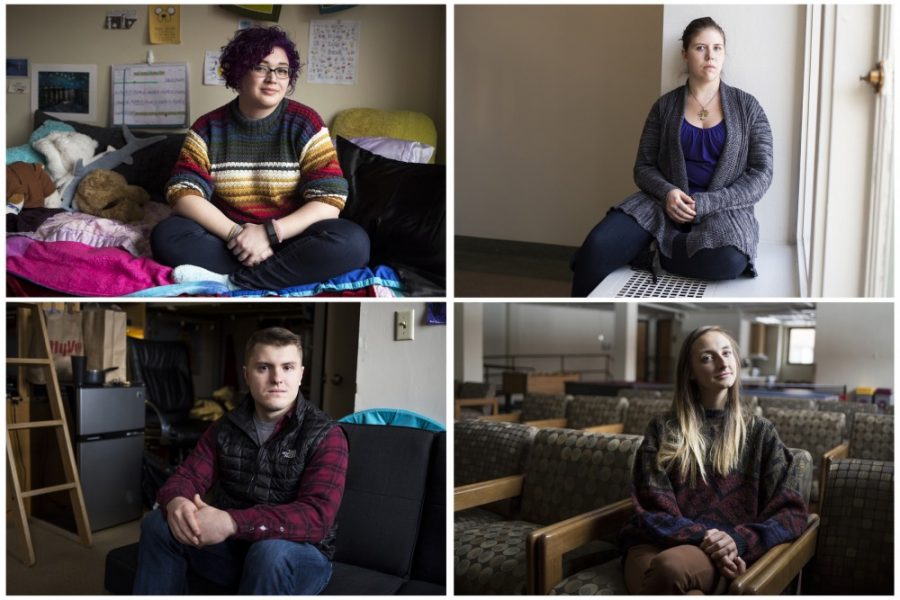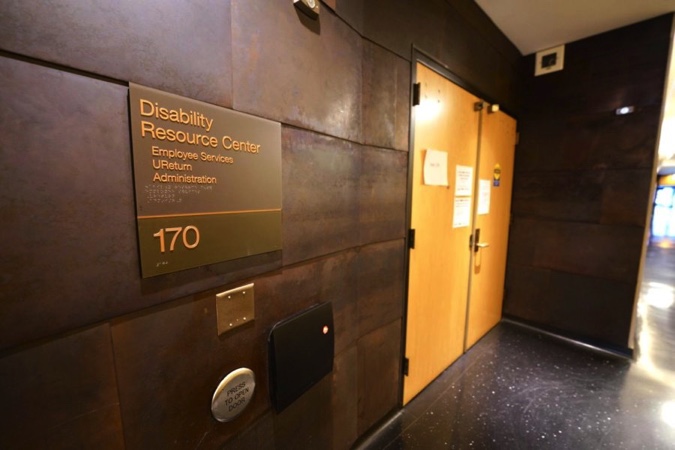Sammy Miller found herself struggling to shake intrusive thoughts of suicide in her dorm room one night during her freshman year.
Diagnosed with depression, anxiety and borderline personality disorder, Miller knew what was happening. She called her therapist, who urged her to hand over her antidepressants to the building’s front desk so she wouldn’t be tempted to overdose. Minutes later, police were knocking at her door.
Thinking she’d done the right thing, Miller was confused. The officers told her she could go to the hospital willingly or by force. She called her parents, who took her home for the evening.
At the University of Minnesota, one in three students report having been diagnosed with a mental illness in their lifetime. The school, like many others nationwide, has expanded its mental health resources to meet rising demands.
But for those with more serious illnesses like borderline personality disorder or schizophrenia, finding adequate treatment options can be difficult.

“[Having a mental illness] is a lot more work than people realize, especially with one that’s not talked about a lot,” Miller said. “I love [the push to eliminate] stigma to depression and anxiety … but at the same time, I also feel kind of invisible.”
Receiving a diagnosis
After battling depression throughout high school, Teddy Skillings felt like he could better manage his symptoms by the time he arrived at the University. He relished the newfound freedom of college.
But a few weeks before the start of his sophomore year, Skillings had a manic episode. He thought he won the lottery. His speech became rapid, and he stopped sleeping. He felt invincible.
His parents took him to the hospital, where he was diagnosed with bipolar tendencies.
Skillings took the next semester off from school.
For some students, the social and academic pressure that accompanies college can heighten a mental illness that’s always been present, said Glenn Hirsch, the director of the University’s Student Counseling Services.
While some people are diagnosed with a mental illness in elementary school, others’ illnesses materialize in early adulthood, he said. The typical age of diagnosis varies from illness to illness, he said.
Psychology and gender, women and sexuality studies sophomore Sammy Miller was diagnosed with depression and anxiety in high school and borderline personality disorder during her freshman year. She said she still battles intrusive thoughts periodically.

As she walks to therapy sessions, she occasionally considers stepping in front of the traffic zipping past her. When she’s driving or riding in a car, her mind sometimes strays to how easy it would be to just open the door, she said.
Miller said she’s often preoccupied with being abandoned and struggles with a poor sense of self-identity. Everyday encounters can incite extreme emotional reactions.
“It’s very all or nothing, black or white thinking,” Miller said.
She said she’s still working to completely understand her illness and find the best treatment.
“It’s hard to unlearn that it’s not normal,” Miller said.
Likewise, chemistry sophomore Ravyn Braun has spent years learning how to handle her depression and anxiety — diagnosed when she was 10 years old, shortly after her mother committed suicide.

Maintaining relationships can be challenging when family, friends or significant others, albeit supportive, can’t directly relate to her experiences.
“They just can’t get past that barrier of what it actually feels like,” Braun said. “They don’t really get it.”
She said that after spending half of her life with a diagnosed mental illness, she has trouble discerning her personality from her depression.
“I feel like my personality developed around the depression, so it’s hard to separate,” she said.
It doesn’t help, she said, when people give her unwarranted advice or tell her to just shift her attitude.
“It makes you think that you’re responsible for it,” Braun said. “Like this is my fault because I can’t think myself out of it.”
Finding the right treatment
Sammy Miller can’t get the treatment she needs for her borderline personality disorder at Boynton Health Service.
Instead, Miller goes off campus for individual and group therapy twice weekly — a time commitment her therapist equates to taking a five-credit course.
And as a freshman, Ravyn Braun found she couldn’t consistently book appointments every week at Boynton, so her therapist there directed her to a private practice.
Boynton often refers students with more serious mental illnesses who need long-term help to private treatment options, said Boynton Chief Medical Officer Gary Christenson. He said the health service’s main priority is to help as many students as possible.

“In an ideal world, I’d like to be able to serve the patients’ needs here on campus,” he said. “But we have limited services.”
The University’s health service isn’t intended for providing long-term care, he said, a commonality across colleges nationwide.
“We don’t offer surgery here, for example. We don’t have a cardiologist,” he said. “You’ll have to go outside, and there will be more expense with that. But we do know that we provide the basic services that most students need.”
Miller has an accommodation letter from the University’s Disability Resource Center to help manage her mental illness and stay on top of school work. The letter permits absences, allows her to take exams in a separate room and receive reasonable extensions on papers or projects.

She said the letter helps and that she’s had almost entirely positive experiences with professors or instructors. But Miller said it can still be intimidating to talk with her teachers about her illness and said she doesn’t want them to think she’s lazy.
“You just never know what someone’s reaction is going to be,” she said.
Learning to cope
During her freshman year at another school, senior Jordan Pinneke stopped eating. She slept excessively. She lost weight. She worried about being a failure and paying for college.
Pinneke’s depression and anxiety symptoms became so debilitating that she had to leave school for two months.
Since then, Pinneke — who transferred to the University of Minnesota her junior year — has developed coping mechanisms like meditating, exercising and spending time with friends.
The urban studies major volunteers at an elementary school and works at a coffee shop, a pizza restaurant and for Student Unions and Activities. She also works as a community adviser in a residence hall. Her busy schedule does more than help pay the bills, Pinneke said, it’s also a way to keep herself healthy.

Skillings, now a senior, still faces periodic hypomanic episodes and difficult bouts of depression.
“Usually, when I’m in a more depressed mode I feel really unmotivated, and when I do my work, it feels like I’m just going through the motions,” he said.
Other times, he’ll experience a less severe hypomanic episode that induces productive, energetic and sleepless sensations.
“Usually, people with bipolar kind of like their mania,” he said. “But you have to learn how to manage it because it’ll get out of hand almost every time you experience it.”
Skillings said when he’s in a hypomanic episode, he takes an antipsychotic that he keeps on reserve. He also visits a Boynton psychiatrist every four to six weeks.
Still, it takes rigorous discipline to stay regulated. Skillings said he has to be diligent about getting adequate sleep and limiting his caffeine intake. He also carefully structures his days in order to avoid creating unnecessary anxiety.

“The best thing you can do for yourself is know yourself and know your limits. And I think once you do that, you’re able to convey it to people more when you need help,” he said. “If you’re honest with yourself, you can be honest with others.”
Skillings has lived in his fraternity’s house throughout his time at the University and said he has relied on that social support.
He is currently working with the Interfraternity Council to address mental health and said he wants to create a better network of support for students in the greek community.
But asking for help can sometimes be difficult. Pinneke said that while she believes the University provides adequate resources, misconceptions and the mental health stigma still prevent open conversations.
The demanding nature of college can sometimes heighten mental health- and stress-related issues for students, Pinneke said.
“People try to out-stress each other,” she said. “As a college student, you’re expected to be stressed.”
Prevention and treatment on campus
The University of Minnesota and its students aren’t alone with the mental health challenges they face.
More than 95 percent of university counseling center directors across the country said the number of students with significant psychological problems is a growing concern for their campuses, according to a 2012 survey by the Association for University and College Counseling Center Directors.

In order to address the stigma and high student stress levels, the Minnesota Student Association prioritized its mental health platform for the 2015-16 school year.
The group is advocating to reorganize mental health funding so all services are paid for through tuition rather than student fees. Members also have pushed to have a mental health screening day for all students, President Joelle Stangler said.
“By and large, I think we just need to have a better awareness and culture toward mental health on campus and really [ensure] that students aren’t overburdening themselves and that they’re aware of the resources available,” she said.
More college students than ever are stepping onto campus with prior mental health treatment, said Micky Sharma, director of counseling services at The Ohio State University and president of the national association for collegiate counseling centers.
“Higher education has become more of an opportunity for more people,” he said. “That means institutions need to be prepared for who’s on campus today.”

Sharma said schools can reduce the stigma on campuses with broad outreach, thoughtful programming, and by engaging faculty staff and students in conversations about mental health.
“Why is it I can ask you publicly about a flu shot, but I can’t ask you if you ever took Prozac? That’s stigma,” he said.
It can be more difficult for universities in smaller cities to make referrals to private practices for students who need need treatment options that exceed their school’s resources.
Still, schools are always responsible for helping students access the care they need — even if they can’t be the ones to provide the specialized resources needed to treat serious mental illnesses, said Glenn Hirsch, the director of the University’s Student Counseling Services.
He said the University’s Student Counseling Services tries to keep wait times short so counselors can refer as many students as possible to the best treatment options.
Hirsch said while schools play an important role in addressing the mental health stigma across their student bodies, the best way to create change is at a grassroots level.
“The most powerful way of doing that, I think, is to have students who are … challenged by these illnesses be able to speak out and talk about their experiences,” he said.
After graduating with a degree in psychology, Sammy Miller hopes to work as a therapist or mental health advocate.
“I want to help people,” Miller said. “When you experience this … you don’t want it to happen to anyone else.”
Graphics sources: National Alliance on Mental Illness, 2015 College Student Health Survey University of Minnesota-Twin Cities Students Report, the Association for University and College Counseling Center Directors.
Graphics: Max Fulton, Photos: Liam James Doyle, Interactive: Ethan Nelson
















